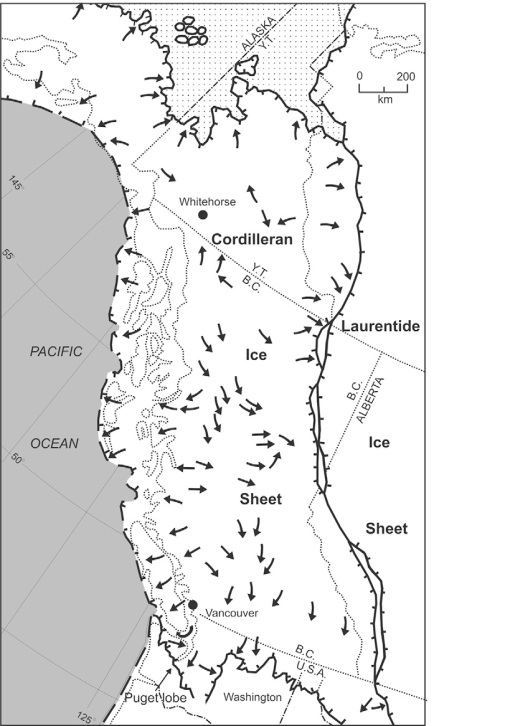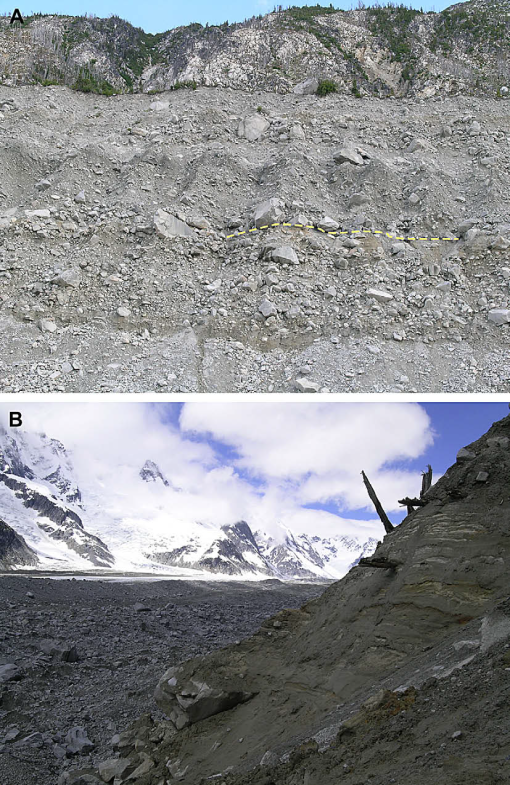
The image above shows the estimated extent of the Cordilleran Ice Sheet approximately 17 thousand years ago. As one can see parts of the Ice Sheet extended into northern parts of Washington and Montana.
After the late Pleistocene glacial retreat there was a period during the early Holocene where there was glacial advance in the Canadian Rockies that is referred to as the neoglacial period by scientists. This neoglacial period occurred approximately 7.5-5 thousand years ago and resulted in the advance of some glaciers within the southern coast mountains of British Columbia and the southern mountains of Alberta. In the recent retreat of these glaciers stumps have been revealed that have been dated 6.95-5.62 thousand years ago. Radiocarbon dating of these stumps and detrital wood have proven this mid-Holocene glacial expansion that scientists refer to as the Garibaldi Phase. They chose to use the word phase rather than advance because there was no evidence of glacial retreat during this time period.

Figure 1. The image above shows the study area for the stumps and detrital wood that was found to show the glacial expansion during the Garibaldi Phase. There is significant evidence in this region to explain how during the early Holocene glaciers within the Cordilleran Ice Sheet began to advance slightly after their slight retreat in the late Pleistocene.
This neoglacial phase occurred prior to what is known as the Little Ice Age which describes glacial advances in the last millennium, with a focus on advances during the 12th and 13th centuries. Most of the neoglacial period occurred before a slight warming of the climate during the early years of the last millennium that is known as the midevil warming period. Glaciers of the Little Ice Age reached their maximum extents during the 17th-19th centuries and began their retreat during the early 20th century.

Figure 1. The image above shows one of the stumps that was radiocarbon dated to be from the late neoglacial period. Five other stumps were found within close proximity to this one dating back to the same time period.

Figure 3. The image above shows till fabric from the Tiedemann Glacier that has been studied and dated back to the neoglacial period approximately 13.5 thousand years ago.
It has been estimated from reports on 120 glaciers in the Canadian Rockies that there was a twenty-five percent loss of ice from the Little Ice Age to the 1970’s. Prior to the Little Ice Age there was a period of warming that occurred in the late neoglacial period that some scientists refer to as the midevil warming period as it occurred from the 11th to the 15th centuries.
References
Images & Information
Menounos, Brian, Gerald Osborn, John J. Clague, and Brian H. Luckman. “Latest Pleistocene and Holocene Glacier Fluctuations in Western Canada.” Quaternary Science Reviews 28.21-22 (2009): 2049-074. Science Direct. Web. 10 Nov. 2012. <http://0-www.sciencedirect.com.skyline.ucdenver.edu/science/article/pii/S0277379108002977#>.
Leave a comment